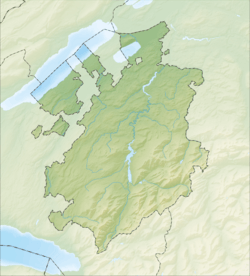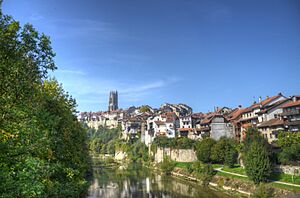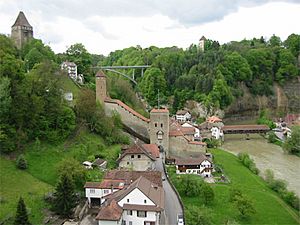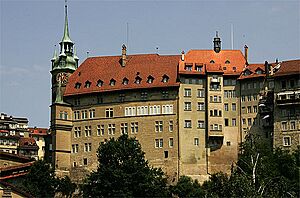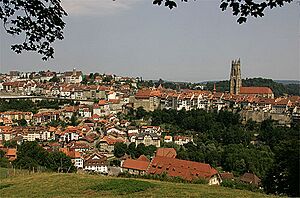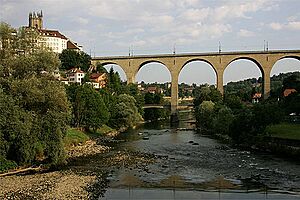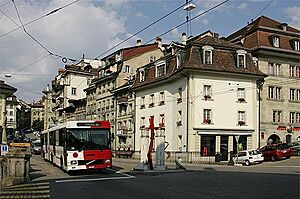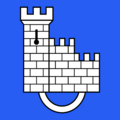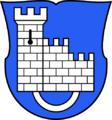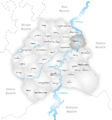Fribourg facts for kids
Quick facts for kids
|
|||
|---|---|---|---|
|
Municipality
|
|||
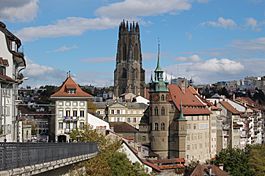
Autumn in Fribourg
|
|||
|
|||
| Country | Switzerland | ||
| Canton | Fribourg | ||
| District | La Sarine | ||
| Area
Lua error in Module:Wd at line 1575: attempt to index field 'wikibase' (a nil value).
|
|||
| • Total | Lua error in Module:Wd at line 1,575: attempt to index field 'wikibase' (a nil value). km2 (Formatting error: invalid input when rounding sq mi) | ||
| Elevation | 610 m (2,000 ft) | ||
| Highest elevation
(Schönberg)
|
702 m (2,303 ft) | ||
| Lowest elevation
(La Sarine (river))
|
531 m (1,742 ft) | ||
| Population
(2018-12-31)Lua error in Module:Wd at line 1575: attempt to index field 'wikibase' (a nil value).
|
|||
| • Total | Lua error in Module:Wd at line 1,575: attempt to index field 'wikibase' (a nil value). | ||
| Demonym(s) | French: Fribourgeois(e) German: Freiburger(in) |
||
| Time zone | UTC+01:00 (Central European Time) | ||
| • Summer (DST) | UTC+02:00 (Central European Summer Time) | ||
| Postal code(s) |
1700
|
||
| SFOS number | Lua error in Module:Wd at line 1575: attempt to index field 'wikibase' (a nil value). | ||
| Localities | Bourg (Burg), Beauregard, Jura, Pérolles, Neuveville (Neustadt), Auge (Au), Schoenberg (Schönberg), Places (Plätze), Bourguillon (Bürglen) | ||
| Surrounded by | Düdingen, Givisiez, Granges-Paccot, Marly, Pierrafortscha, Sankt Ursen, Tafers, Villars-sur-Glâne | ||
| Twin towns | Rueil-Malmaison (France) | ||
| Website | SFSO statistics |
||
Fribourg is a beautiful city in Switzerland. It's the main city of the Fribourg canton and the La Sarine district. The city sits on both sides of the Sarine River. It's a key place for business, government, and education. Fribourg is special because it's where German-speaking and French-speaking Switzerland meet.
The city's Old City is one of the best-preserved in Switzerland. It's built on a rocky hill above the Sarine valley. In 2018, about 38,365 people lived in Fribourg.
Contents
History of Fribourg
Early Times and Founding
People have lived in the Fribourg area since the Neolithic period (Stone Age). Not many old items have been found, but some flint tools and bronze tools show people were here. During the Roman times, there was a river crossing.
The city of Fribourg was started in 1157 by Berthold IV, Duke of Zähringen. Its name comes from German words meaning "free fort." The oldest part of the city is on a peninsula formed by the Sarine River. This spot was easy to defend because of the steep cliffs around it. This strong location helped the Zähringen Dukes grow their power in Switzerland.
Growth in the Middle Ages
Fribourg quickly grew into its own city-state. After the Zähringen dukes died out in 1218, the city went to the Kyburg family. They gave Fribourg special rights and wrote down its laws in 1249. The city also made agreements with nearby cities like Bern.
In 1277, Fribourg was sold to the Habsburgs. Trade and industry, especially making cloth and leather, became very important. Fribourg became famous in Central Europe for these goods by 1370. The city expanded quickly, showing its economic success.
Fribourg joined the Habsburgs in a battle against Bern in 1339. In 1403, the city renewed its agreement with Bern. Fribourg's leaders started taking control of more land nearby. By 1442, the city controlled land up to 20 kilometers away on both sides of the Sarine River.
The mid-1400s had many wars. Fribourg joined Bern in a war against Charles I of Burgundy and gained more land. After this, Fribourg became a "Free Imperial City" in 1478. This meant it was directly under the Holy Roman Emperor.
In 1481, Fribourg and its canton joined the Swiss Confederacy. The city continued to grow in the 1500s. It gained more land after helping Bern invade Vaud in 1536 and by taking over land from the Count of Gruyère in 1554.
Wealthy families grew from the cloth and leather trades. These families eventually became the "patrician" class, who were the main rulers of the city. This change also led to the decline of the cloth trade, as these families focused more on governing. In 1627, these patrician families made a new law. It said only they could rule the city, making Fribourg an oligarchy (ruled by a small group).
Churches and Monasteries
Monasteries in Fribourg were very important for religious culture. They helped with architecture, art, and education. The Franciscan monastery was built in 1256. Its church was used for town meetings for a long time. The Augustinian monastery was also founded in the 1200s. La Maigrauge Abbey has been a Cistercian monastery since 1262. A public hospital opened in the mid-1200s to help the poor.
During the Reformation, Fribourg stayed Catholic. This was important because it was surrounded by Protestant areas like Bern. Fribourg became a major center for the Counter-Reformation. New monasteries were built, like the Capuchin and Ursuline monasteries.
The Jesuits were very influential. They started the College of Saint Michael in 1582. This college's theology (religious study) department later became the basis for the University of Fribourg. In 1613, Fribourg became the home of the Bishop of Lausanne.
Changes in the 18th and 19th Centuries
A small group of about 60 wealthy families controlled Fribourg completely. People tried to revolt, but these attempts were stopped. In 1798, French troops invaded Switzerland. Fribourg surrendered, and the old ruling system ended. The city held its first elections.
Under Napoleon in 1803, Fribourg became the capital of its region and canton. For a few years (1803-1809), it was even one of Switzerland's capitals.
The old ruling families got back control in 1814. But in 1830, a new, more open constitution was created. Fribourg was part of the Sonderbund (a "separate alliance") from 1845-1847. This was a group of Catholic cantons that wanted to leave Switzerland. Fribourg and the Sonderbund lost a short civil war in 1847. Since 1848, a new national constitution has given all citizens the right to vote.
Modern Fribourg
The late 1800s and 1900s brought big changes. Parts of the city wall were taken down in 1848. A new bridge was built over the Sarine. When the railway line opened in 1862, a new "railway station quarter" grew. Better transport helped Fribourg become industrialized. The city's main center moved from the Old City to the new station area.
The University of Fribourg opened in 1889, which was a big event for the city. The A12 highway also helped Fribourg's economy.
Geography and Nature
Fribourg is about 581 meters above sea level in its Old City. It's about 28 kilometers southwest of Bern. The city is on the Swiss plateau and spreads out on both sides of the Sarine River. The Sarine has cut a deep valley here. The Old City is on a narrow hill, about 40 meters above the valley. Most of the city is on higher ground, around 620 meters high.
Fribourg covers about 9.3 square kilometers. About 13.4% of this land is used for farming, and 17% is covered by forests. Most of the land (63.3%) is developed with buildings or roads. Rivers and lakes make up 5.7% of the area.
The Sarine River flows through the city from south to north. It has carved a valley that can be 100 meters deep. South of the city is Lac de Pérolles, a lake created by the Maigrauge Dam in 1872. This was the first gravity dam in Europe. Just north of the city is the start of the Schiffenensee lake.
The hills around the river are steep and mostly wooded. To the east, the city reaches up to Mount Schönberg, which is the highest point in Fribourg at 702 meters.
People and Languages
Population in Fribourg
Fribourg has a population of about 38,000 people. Many people from other countries live here (about 31.9% in 2008). The population grew a lot in the early 1900s and from 1930 to 1970. The highest population was around 42,000 in 1974.
The larger area around Fribourg, including nearby towns, has about 110,000 people. These areas are growing together with the city.
Languages Spoken
Most people in Fribourg (about 63.6%) speak French as their main language. German is the second most common language (about 21.2%). Italian is spoken by about 3.8% of the people. A few people in the Basse-Ville area speak "Bolze," which is a mix of French and Swiss German.
Fribourg and its canton have two official languages: French and German. French is used more often in the local government and in daily life. Even in German, the city is often called "Fribourg" instead of "Freiburg." This helps people tell it apart from Freiburg im Breisgau in Germany.
Religion in Fribourg
Fribourg has a strong Catholic history. About 69.2% of the people are Roman Catholic. Around 7.8% belong to the Swiss Reformed Church (Protestant). Other religions are also present, including Orthodox Christians, Muslims, Buddhists, and Hindus. About 8% of the population does not belong to any church.
Fribourg remained Catholic during the Reformation and has been a center for Catholicism ever since. It has many churches and monasteries. Since 1613, Fribourg has been the home of the Bishop of Lausanne, Geneva and Fribourg.
Economy and Jobs
How Fribourg's Economy Grew
Industries started in Fribourg as early as the 1200s and 1300s. The city's growth along the Sarine River showed a strong economy. Water power from the Galterntal valley was used for mills. New trade areas developed along the Sarine.
Making leather and cloth was very important in the 1300s and 1400s. Fribourg became well-known for these products. But the cloth industry slowly declined in the late 1400s. This happened partly because farmers started raising cattle instead of sheep. Also, the city's leaders didn't want to use new materials or styles.
Fribourg didn't become industrialized until the railway arrived in the 1870s. After Lake Pérolles was built in 1872, it provided power to the area. This led to an industrial zone with factories. A chocolate factory was built nearby in 1901.
In the 1900s, the plateau area became the city's industrial heart. New industrial areas in nearby towns have helped the economy keep growing.
Fribourg's Economy Today
Today, Fribourg has a low unemployment rate (4.9% in 2010). Most jobs are in the service industries. Many people work in government, education (at the university), banks, and insurance companies. Tourism, restaurants, and health services are also important.
Fribourg has more jobs than people living there. This means many people from surrounding areas come to Fribourg for work. Local industries include food, drinks (like breweries), metal and machine building, electronics, and computer technology. The Cantonal hospital is also a major employer.
Education in Fribourg
Fribourg offers schools in both French and German. The University of Fribourg is officially bilingual. This means students are expected to understand both languages, though they can get a degree in just one. The university is known for its law and theology programs.
Other schools include the University of Applied Science Fribourg, which teaches technical and management skills. There's also a multimedia and art school.
Fribourg has several libraries. In 2008, these libraries had over 3.5 million books and other media. They loaned out over 611,000 items that year.
Many people in Fribourg have completed higher education. About 32.8% have finished high school, and 16% have gone on to university or a specialized college.
The Canton of Fribourg's school system starts with one year of optional Kindergarten. Then there are six years of primary school. After that, students go to three years of lower secondary school, where they are grouped by their abilities. Then they can choose a three or four-year upper secondary school, which can be a gymnasium (for university prep) or a vocational program. After upper secondary, students can go to university or start an apprenticeship.
The University of Fribourg is a popular place for students from other countries, especially through programs like Erasmus.
Transportation
Fribourg is a very important transport hub in its canton.
Roads
The city is on the old main road from Bern to Vevey. It also connects to other towns like Payerne, Morat, and Thun. The A12 motorway, which connects Bern to Vevey, reached Fribourg in 1971. The A1 motorway, which goes from east to west in Switzerland, bypasses Fribourg to the north and west. There are two main exits for Fribourg, about 3 kilometers from the city center.
Railway Connections
Fribourg got its first railway connection in 1860. The line from Bern to Fribourg opened on July 2, 1860. A temporary station was used until the main Fribourg/Freiburg railway station opened in 1873. Lines to Payerne and Morat opened later in the 1870s and 1890s.
Public Transport
A special funicular railway has been running from the Neuveville district to the upper city since 1899. The Fribourg funicular is unique because it's one of the few water-powered funiculars left in the world. It's even powered by sewage water! The sewage is pumped into the car going down, making it heavier, and then released at the bottom.
From 1897 to 1965, Fribourg had a tram network. Trams were replaced by trolleybuses starting in 1949. Today, the bus network is run by Transports publics fribourgeois. It connects Fribourg to many surrounding towns.
The regional Bern-Belp Airport is about an hour away.
Culture and Fun
Fribourg is a great place for a day trip. Tourists love to visit the historic Old City. The Cathedral of Saint Nicholas is famous for its beautiful stained glass windows.
Fribourg has several museums:
- The Natural History Museum, started in 1873.
- The Museum of Art and History, with exhibits on ancient times, sculptures, paintings, and crafts.
- A treasure chamber in the cathedral.
- The Swiss Museum of Marionnettes (puppets).
- The Swiss Sewing Machine Museum.
- The Gutenberg Museum (about printing).
- The Bible and Orient Museum.
- A beer museum.
The city also hosts many cultural events. These include a religious music festival, an international folklore convention, a jazz parade, and the Fribourg International Film Festival.
Fribourg has kept its medieval center very well, making it one of the largest in Europe. It's on a stunning peninsula, surrounded by the Sarine River. The buildings in the Old City are mostly from the Gothic period, built before the 1500s. Most houses are made of local stone. The Old City has many old fountains and churches.
The cathedral is 76 meters tall and was built between 1283 and 1490. Fribourg's old walls are also very important medieval military structures in Switzerland. There are 2 kilometers of walls, 14 towers, and a large bulwark. These defenses are especially well-preserved on the east and south sides of the city.
Important Historic Sites
Fribourg has 67 buildings or sites that are listed as important Swiss heritage sites.
Some of these include:
- Religious Buildings: Maigrauge Abbey, the former Augustinian Convent, Notre-Dame Basilica, Saint-Nicolas Cathedral, and various chapels and monasteries.
- Secular Buildings: The former Post Office, the Maigrauge power plant, the Poya Castle, the City Hall (Hôtel de Ville), the historic fortifications, and the Fribourg funicular.
- Houses and Private Buildings: Many historic houses with unique names, showing the city's past.
- Schools: Collège Saint-Michel and the University Miséricorde.
- Archives, Libraries, and Museums: The State Archives, City Archives, Cantonal and University Library, Gutenberg Museum, and the Museum of Art and History.
- Fountains: Several beautiful old fountains like the Fountain de la Fidélité and Fountain de Saint-Georges.
- Bridges: Important bridges like the Pont de Bern and Pont du Gottéron.
Sports in Fribourg
Fribourg has several popular sports teams.
- Ice Hockey: The most popular team is HC Fribourg-Gottéron. They play in the National League (NL) at the BCF Arena. They haven't won a Swiss championship yet, but they've been runner-up five times.
- Basketball: The basketball team is Fribourg Olympic. They play at the Holy Cross College gym. They have won 13 championships and several Swiss Cups.
- Football: The football club FC Fribourg plays in a lower division of Swiss Football.
Every year, on the first Sunday in October, a race called the "Murtenlauf" (Murten Run) is held. It goes from Murten to Fribourg and is about 17 miles long. It remembers the Battle of Murten and is a very popular fun run in Switzerland.
Famous People from Fribourg
Many interesting people have lived in or are from Fribourg:
- Petrus Canisius (1521–1597), a Dutch Jesuit priest who lived in Fribourg and founded the Jesuit Collège Saint-Michel.
- Hans Gieng (died 1562), a Swiss Renaissance sculptor known for his public fountain statues.
- Louis Agassiz (1807–1873), a famous Swiss-American biologist and geologist.
- Jean Tinguely (1925–1991), a Swiss sculptor known for his moving art machines.
- Anni-Frid Lyngstad (born 1945), a singer from the famous pop group ABBA, who lives near Fribourg.
- Jo Siffert (1936–1971), a Swiss F1 racing driver.
- Alain Berset (born 1972), a Swiss politician who has been a member of the Swiss Federal Council.
Sister Cities
Fribourg has one sister city:
 Nova Friburgo, Brazil
Nova Friburgo, Brazil
Images for kids
See also
 In Spanish: Friburgo (Suiza) para niños
In Spanish: Friburgo (Suiza) para niños





